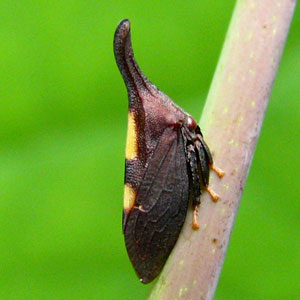Leaf Feeders
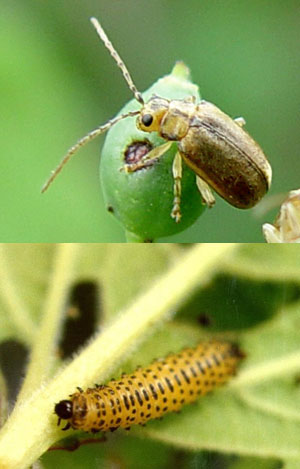
adult: Paul Weston, Cornell University, Bugwood.org;
larva: Bruce Watt, University of Maine, Bugwood.org
The adult Viburnum leaf beetle is a yellow-brown color and around 1/4 inch long. The larvae are yellow-green, 1/3 inch long, and have a series of black dots and stripes on their back. Adult feeding causes oblong holes in viburnum leaves while larvae skeletonize leaves (similar to Japanese beetles). This species overwinters as an egg; larvae emerge in May to feed through June. Pupation and adult emergence happen in July. Females will lay their eggs in holes chewed into viburnum twigs in October. There is one generation per year.
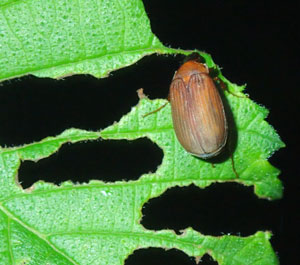
Whitney Cranshaw, Colorado State University, Bugwood.org
Asiatic garden beetle adults are around 1/2 inch long and shaped like a Japanese beetle. They are brown and feed on many different plants at night. The larval stage is a C-shaped white grub that tends to live in and feed on overgrown turf areas. Generally, the larvae are not a pest but can damage plants occasionally. Adults will consume leaves and flowers and are attracted to lights. There is one generation per year, with adults most active in July and August. The overwintering stage is the last grub instar.

Alton N. Sparks, Jr., University of Georgia, Bugwood.org
Thrips are very small, elongate insects that feed by puncturing the outer skin of the leaf and sucking out the fleshy leaf tissue. Their feeding causes off-colored foliage and stunted growth.
Sap Feeders
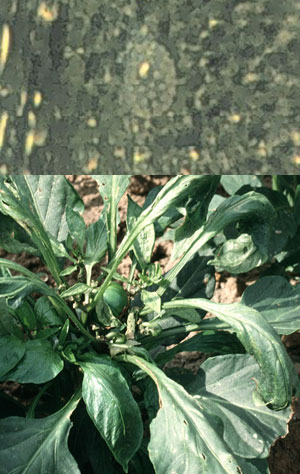
egg: Rayanne Lehman, Pennsylvania Department of Agriculture, Bugwood.org;
damage: David Riley, University of Georgia, Bugwood.org
Broad mites are small, hard to see mites that can reproduce quickly and establish a thriving population. You will need magnification in order to see them or their eggs. The eggs are characteristic; they are clear spheres covered with numerous white dots. Symptoms are usually seen on newest growth. Leaves turn downward and look purple or copper, nodes may weaken, flowers are distorted and do not open.
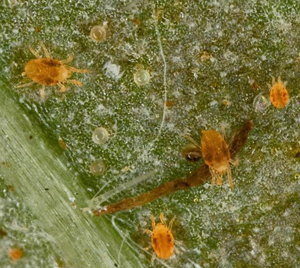
David Cappaert, Bugwood.org
Twospotted spider mites are tiny (1/50 inch) arthropods with a dark spot on each side of the oval, light green to yellow body. They live on the underside of leaves and use needle-like mouthparts to remove the contents of individual cells. This produces tiny white to yellow spots on leaves, sometimes called flecking or bronzing. These mites produce fine silk-like webbing that often covers infested plants. Infestations are usually most serious during hot, dry periods.
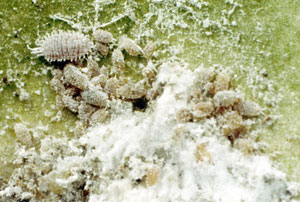
Clemson University - USDA Cooperative Extension Slide Series, Bugwood.org
Comstock mealybugs are small, oval, waxy pests that feed on the sap of plants. Adult females are 3/16 inch long; the body is a brownish color but is coated with a white wax. They produce honeydew as fecal material which can also encourage the growth of black sooty mold on the plant. There are two generations per year, with overwintering eggs hatching in the spring. Spring nymphs feed and mature by July. They mate and then produce another generation that matures by September
Treehoppers are small, active insects that live on the underside of the leaves. They use sucking mouthparts to feed on plant sap. They are very similar to leafhoppers, but have exaggerated pronotums that may resemble humps, thorns, or spikes. Usually large numbers are present by the time the injury is obvious. Heavily damaged leaves may drop early but this insect usually does not cause serious problems
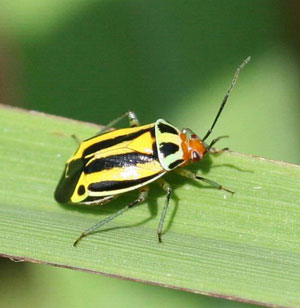
Johnny N. Dell, Bugwood.org
Four-lined plant bug adults are between 1/4-1/3 inch long, have an orange head and yellowish body with four black stripes running down the back. The nymphs are red to red-orange with black dots. There is one generation per year, with feeding and growing occurring in May and June. As they feed, four-lined plant bugs create circular brown-black spots. The spots are about 1/16-inch wide and can merge together to create a blotchy appearance that resembles a disease issue. The damaged spots can also dry and fall out of the surrounding healthy tissue, leaving a hole behind.
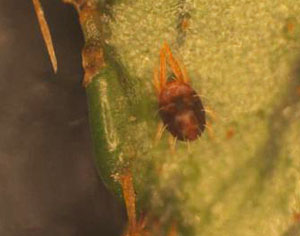
Tracy Wootten, University of Delaware, Bugwood.org
Southern red mite is a cool season mite that can have population peaks in months where the average daily temperature is less than 85°F. They suck juices from leaves in spring and fall, with damage often becoming the most apparent in the heat of the summer. Early on though, damage will appear like stippling on the leaves with the leaf eventually turning grey or brown and falling from the plant. The mites are quite small but if you knock plant leaves over white paper you will notice tiny red dots moving.
Borers
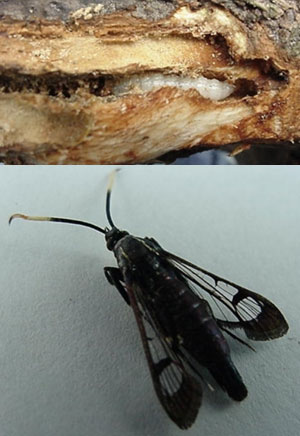
larva: David Parsons, University of Wisconsin, Bugwood.org;
adult: David Parsons, University of Wisconsin, Bugwood.org
There are two species of Viburnum crown borers, the Viburnum clearwing borer and the Lesser viburnum borer, which are both clearwing moths. The damaging stage is the caterpillar, which bores into the lower trunk, branches, and roots of viburnum. As adults they look similar to one another; both are day-flying, 1/2 inch long, bluish-black moths. The Viburnum clearwing borer has white markings on its face; the Lesser viburnum borer does not. Caterpillars reach about 1/2 inch and are pinkish with a brown head. Symptoms include branch dieback, swellings and cracks near the base of the plant, and emergence holes with pupal skins in them. Adult moths are active starting in June and caterpillars feed into the fall and then overwinter.
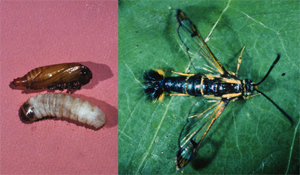
larva, pupa: J.A. Davidson, Univ. Md, College Pk, Bugwood.org
adult: David Laughlin, Horticultural student, Bugwood.org
Dogwood borers are white caterpillars with yellow heads that feed beneath the bark and produce a sawdust-like waste that accumulates at openings on the bark. Infestations usually develop at or around wounds in the bark
